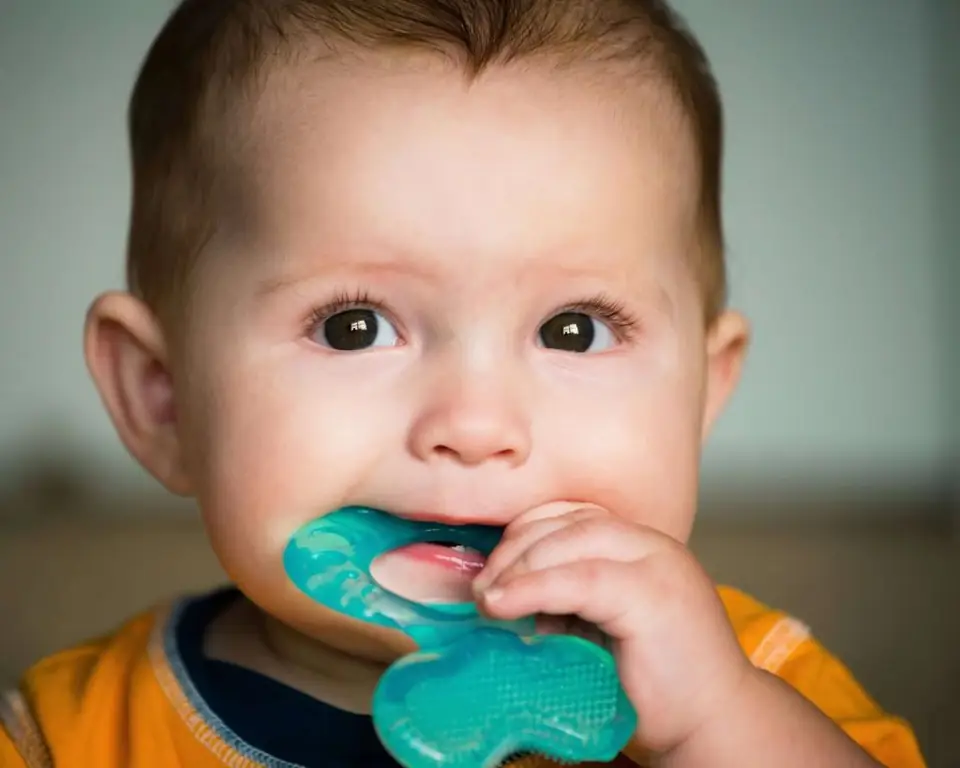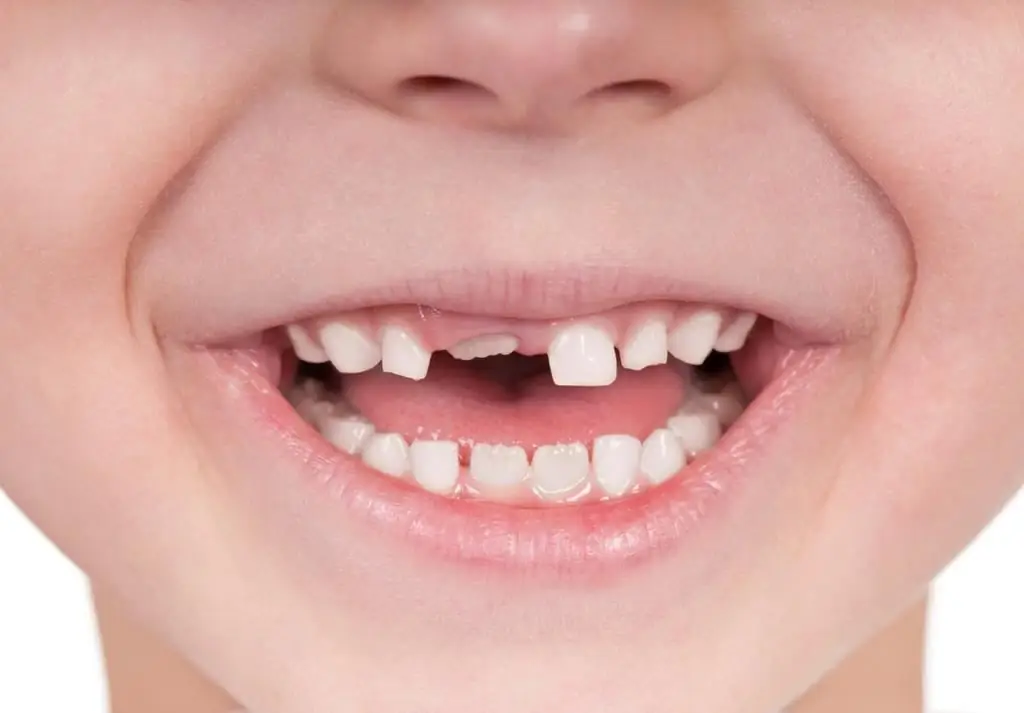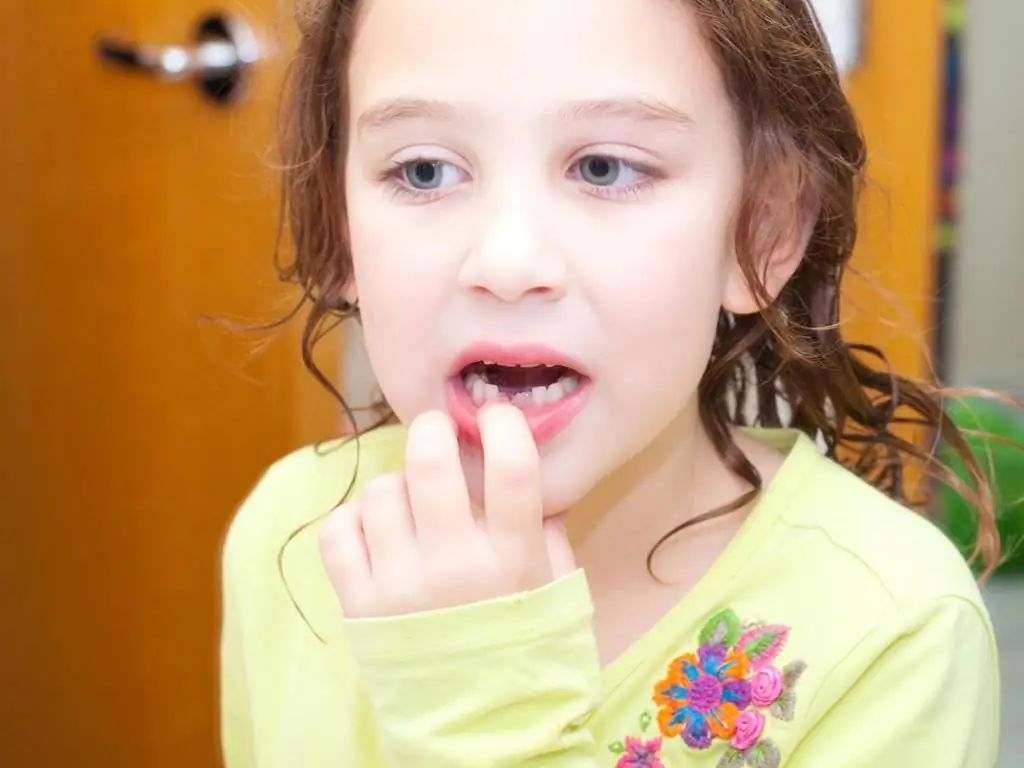2026 Author: Priscilla Miln | [email protected]. Last modified: 2025-01-22 17:55:26
Let's talk about the process that worries both children and their parents. This is the change of teeth in children. Dairy ones change to permanent ones, starting at the age of 6. This process is delayed for 7-9 years. According to dentists, permanent roots are fully formed by the age of 16, and the entire dental apparatus - only by the age of 20. Moreover, a person changes only 20 teeth during his life, and the rest initially erupt as permanent.
Interesting facts
Before introducing the scheme of changing milk teeth in children, read the important interesting facts:
- Baby teeth begin to form while the baby is still in the womb.
- An adult has 32 teeth - 16 on the top and 16 on the bottom. And the child has only 20 dairy.
- Permanent teeth begin to develop in the gums after the baby is born.
- In 90% of cases, the eruption of molars is painless.
- The first "sixes" (molars) appear in a child. Interestingly, they do not provoke milk loss, because they get up indental arch where there are none.
- So-called "wisdom" teeth don't always appear in the late teens. Often they erupt already in an adult. There are cases when "eights" are not shown at all.
- Roots of milk teeth dissolve, causing them to leave the gum.
- The bottom row starts to change first in most cases.
- On average, the change of milk to permanent teeth takes place from 6 to 14 years. The average duration of the process in years is 6-8.
- The rate of eruption of new teeth and loss of old teeth is affected by a large number of factors. This is heredity, and the quality of nutrition, and drinking water. The latter can cause pulpitis and caries. Therefore, the child should be given high-quality and mineral-rich water.
- Also, the region of residence, the standard of living of the family, a number of diseases suffered by the child can also affect the speed of changing teeth.

Why do milk teeth fall out?
Not many ask such a curious question. And the timing of the change of teeth in children has quite understandable reasons:
- The first dairy products are designed for more liquid, soft and tender food. Their enamel is not strong enough. With age, the body needs to be replaced with something more durable.
- As a child develops, his jaw apparatus expands. In some children, gaps between milk teeth even begin to appear. Enlarged jaw, reinforced chewing apparatus need larger incisors,canines and molars.
The order of changing teeth in children
Now to the specific information. In the table, we will consider the approximate timing of the change of milk teeth in children.
| Type of baby teeth | Age of onset of root resorption, years | Age of tooth loss, years |
| Central lower and upper incisors | 5 | 5-7 |
| Lateral lower and upper incisors | 6 | 7-8 |
| Small lower and upper molars | 7 | 8-10 |
| Large lower and upper molars | 7 | 11-13 |
| Lower and upper fangs | 8 | 9-11 |
Now let's move on to the time of the appearance of already permanent dental apparatus.
Eruption of permanent teeth
With reference points regarding dairy, everything is already clear to us. At what time does the change of teeth in children to permanent, we will consider in the table below.
| Type of permanent teeth | Eruption age, years |
|
Lower central incisors Upper and lower 1st molars |
6-7 |
|
Upper central incisors Lower lateral incisors |
7-8 |
| Toplateral incisors | 8-9 |
| Lower fangs | 9-10 |
| Upper 1st premolars | 10-11 |
|
Lower 1st premolars Upper 2nd premolars |
10-12 |
|
Upper fangs Lower 2nd premolars |
11-12 |
| Lower 2nd molars | 11-13 |
| Upper 2nd molars | 12-13 |
| Upper and lower 3rd molars | 17-20 |
Go to the next topic.
What to expect during the change of baby teeth in children
Let's share with you facts, many of which you might not know:
- During the shift, dentists advise additional loosening of milk teeth. Children can handle this simple procedure on their own.
- The roots of those milk teeth that were once treated, dissolve more slowly. Most often they have to be removed.
- If, after self-loss of a tooth, the wound began to bleed, then it is enough to attach a sterile cotton swab to it. Also, as after removal, you should not eat anything for 2 hours. It is not necessary to rinse your mouth with something - a cork forms in the wound, preventing the penetration of microbes. It is better to refuse cold, sour, s alty, hot.
- Interestingly, the change of milk teeth in children is almost alwaysoccurs according to the scheme of their eruption in infancy. In the vast majority of cases, the process begins with the lower jaw.

Eruption of permanent teeth
When changing teeth in children, you need to pay attention to the following:
- Vulnerability. When a tooth erupts in a child, its pulp has a larger size than in an adult. Hard tissues are very vulnerable, therefore sensitive to external influences. From this, the child needs to be careful to eat viscous and solid foods. This includes nuts, toffees, lollipops.
- Time. Do not be alarmed if, after the loss of milk, its place is not immediately taken by a permanent one. The term of change can be up to a year. But if after 12 months a new tooth has not appeared, this is a reason to contact a specialist.
- Growth rate. When changing teeth in children, the incisors grow fastest. Slightly slower - fangs. In last place are the molars and premolars. The speed depends on the area of the tooth.
- Deadline violations. Not always the change of teeth takes place according to the schedule, which we presented above. The cause of its violation can be individual characteristics, past infections, heredity. Violations lead to incorrect positioning of the teeth (tilt, rotation), their growth outside a certain arc, and malocclusion.
- Symptoms. Often, when changing teeth, the temperature may rise. This is especially true for molars. It's all about the area of \u200b\u200binflammation of the gums. Also, children may experience swelling of the gums, itching, pain, general fatigue.
- Hygiene. Parentsshould instill in the child the idea that permanent teeth should be properly cared for. This is a high-quality cleaning with a brush (best of all - with soft bristles) and paste (it is better to use special children's types with calcium and fluoride) at least 2 times a day, rinsing your mouth after eating, twice visiting the dentist annually. Pay attention to children's tooth rinses. And during the change of teeth in children, a visit to the orthodontist is mandatory.

Features of food
During the formation of a new dental apparatus, it is important to pay attention to the child's diet. At the age of changing teeth in children, nutrition should be organized thoughtfully:
- Phosphorus. Fish must be present in the diet - at least 1-2 times a week. Look out for low-fat marine species.
- Calcium. Variety and even abundance of the entire range of dairy products. If the child does not eat such food well, then it is worth buying multivitamin preparations with calcium for him.
- Fruits and vegetables. This is not only a source of vital vitamins, such solid food contributes to the loosening of milk teeth, organizes the load on the emerging jaw.
- Restriction in the use of sweets. It is the delicacies so beloved by children that contribute to the formation of lactic acid, which negatively affects tooth enamel. Therefore, it is worth giving up sweet soda water (it is most dangerous), pastries, sweets and chocolate.
Early replacement of teeth
When considering tooth replacement patterns in children, parents oftennotice that their child has lost milk teeth before the due date - up to 6 years. As a rule, this happens most often for a reason - the baby himself loosened the tooth, got injured, survived certain diseases.
The problem here is the following - to the place for which the permanent tooth has not yet "ripened", the neighboring milk teeth begin to move, filling the resulting opening. Hence, when the time comes for the permanent to erupt, there is simply not enough space for it. Therefore, it is highly likely that he will be outside the correct dentition.
To prevent this from happening, you need to contact a pediatric orthodontist as soon as possible. Modern techniques allow you to stop the displacement of adjacent milk teeth, which prevents the appearance of future aesthetic defects, malocclusion.

When should a baby tooth be removed?
Many parents tend to take their child to the extraction of a baby tooth as soon as the latter begins to stagger. However, this should not be done - natural hair loss is more painless.
It is advisable to remove a milk tooth only in the following cases:
- Prevents permanent teeth from erupting (untimely removal can cause curvature of the entire dentition).
- An inflammatory process is brewing around the tooth. An urgent visit to the dentist is needed.
- A badly loose tooth causes discomfort to the child.
Retention
This is the name of the problem in which a milk tooth falls out, but a permanent one does notin a hurry to appear in the vacant place. Experts advise in such cases to worry only when the situation has dragged on for at least a year.
Dentists distinguish two types of retention:
- Full. The formed permanent tooth is in the gum.
- Partial. Only the very top of the crown becomes visible. Everything else is hidden in the gum.
Disturbance is diagnosed by x-ray. Its cause is an incorrect or too deep location of the tooth germ. Most often, retention is solved surgically - a too dense gum hood is cut, hiding the tooth underneath.

Adentia
And this is a more serious problem. In this case, a new tooth does not appear due to the fact that its germ is simply not in the gum. The reason is a violation in fetal development or a disease that the child has experienced.
This pathology is also determined by X-ray. Two of its forms are observed:
- Partial. The rudiment of one or more teeth is missing.
- Full. A very rare form. There are no germs of any permanent teeth in the gums.
Often, such an interesting situation is found on an x-ray - one or more teeth in an adult boy or girl are still dairy. But there is no permanent germ under them. In this case, the milk tooth should be protected as carefully as possible - it is possible to keep it up to 30 or even more years.
Today, adentia is treated only with prosthetics. And, unfortunately, only enoughadulthood, when the jaw is fully formed.

Late dropout
There is one more problem - the permanent teeth begin to "peck", and the dairy ones do not want to make room for them. As a result, there are as many as two dentitions. In this case, you should contact your dentist as soon as possible. Otherwise, not removed milk ones in time will cause the curvature of a number of constants.
Remember that if a milk tooth is in the gum, without even staggering, then it should be removed only after an anesthetic injection. After all, it, like the constant one, has a root, albeit a slightly smaller thickness. If the tooth is already loose, then an anesthetic spray will suffice.

Change of teeth is a rather lengthy process that catches a child as a preschooler and sees him off as a teenager. Parents should monitor its course, enrich the diet of the child with the necessary products, teach the child the rules of personal hygiene. All problems that are specific to the process of changing teeth are best addressed as soon as possible.
Recommended:
The order of teething in children under one year old: sequence, timing and symptoms

Sometimes teething in babies can cause a lot of trouble not only for the children themselves, but also for their parents. This period is different for everyone. Some babies can easily tolerate the discomfort caused by teething, while others may notice the appearance of fever, diarrhea and a number of other symptoms
Until what age do children's teeth grow? In what order do teeth grow in children?

The appearance of the baby's first tooth is an important event in the life of any parent. Equally important is the change of milk teeth to permanent ones, which is why parents have the question of how old children's teeth grow. In this article, we will expand on this topic, find out how the first teeth grow, at what age the change to permanent teeth should occur. We will also answer the question at what age do teeth stop growing completely
Milk teeth in children: symptoms and order of eruption, photo

Teething in babies is the first test for both children and parents. Often this process is difficult. Young mothers and fathers need to know in advance how milk teeth appear in children, symptoms, order and normal terms. Knowledge will make it possible to alleviate this difficult period, and in case of any problems, consult a doctor in time
Change of milk teeth in a child: terms, age limits, procedure for changing teeth, features of the process and advice from parents and doctors

As a rule, children's teeth fall out at a certain age. However, sometimes they are replaced earlier or later than the due date. Let's see what it could be. It is also worth studying the useful recommendations of experts
Anapa, camp "Change". Permits to the children's camp. Children's he alth camp "Change", Anapa

Anapa is a universally recognized he alth resort for children. It is here that some of the best children's sanatoriums and camps are located. The magnificent sea climate and mountain air are the best that nature could give for the normal growth and he alth of the child

